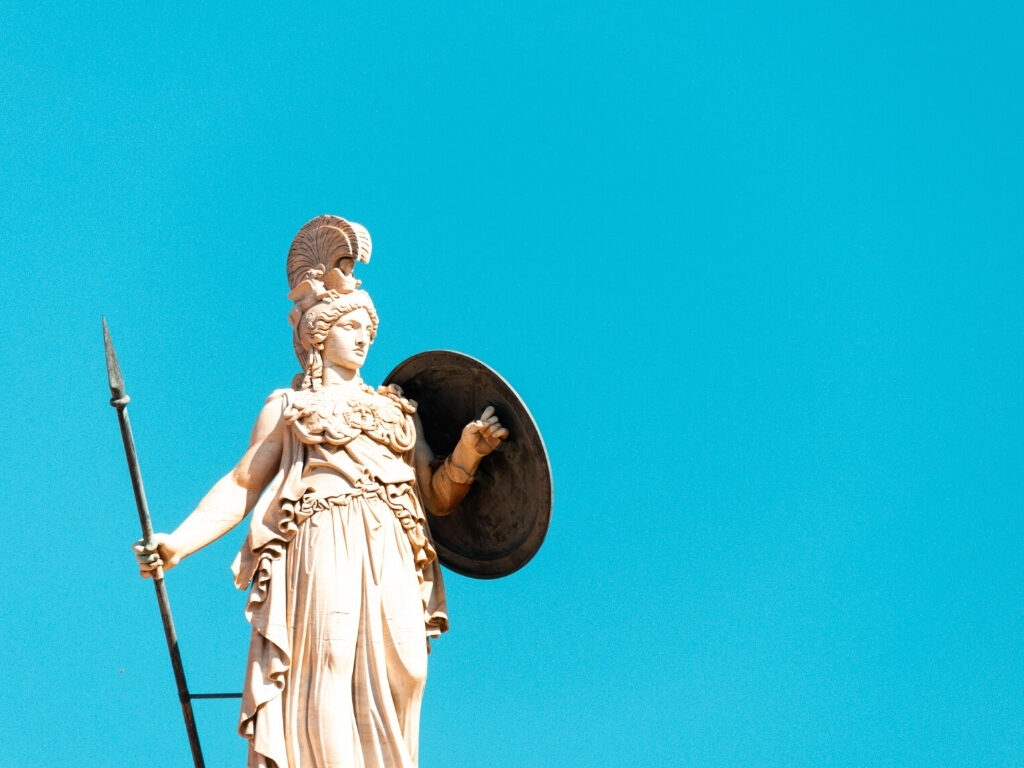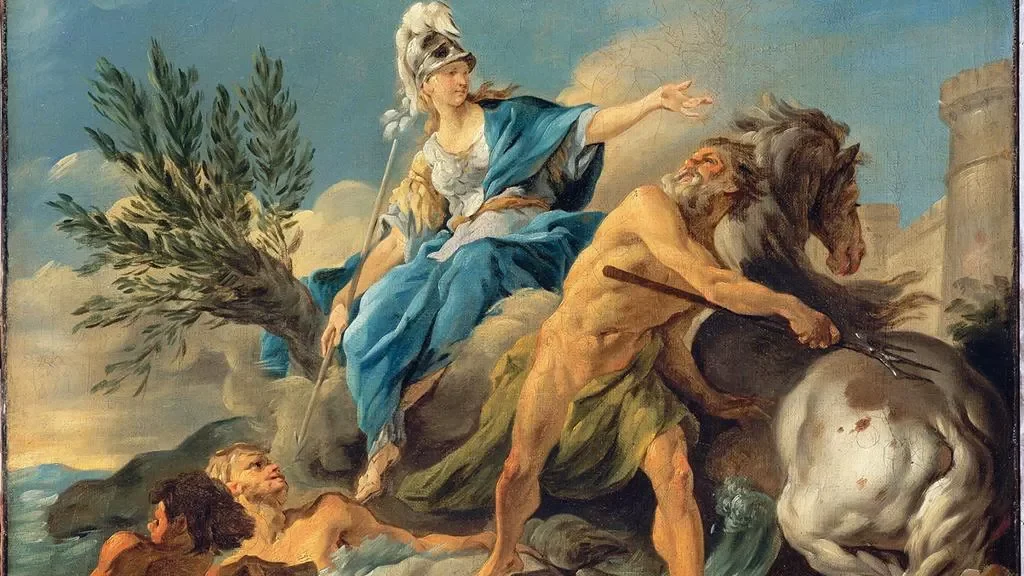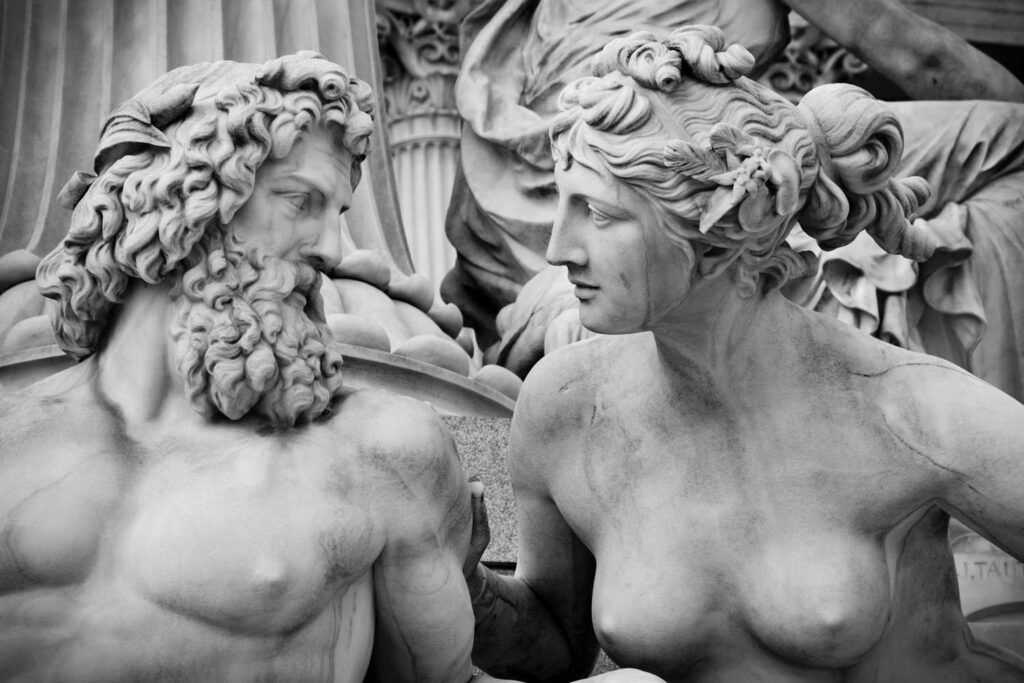
Did you know that the symbols connected to Athena tell us a captivating story of their own?
Today we dive into the fascinating world of Greek mythology, to explore the realm of Greek goddesses and the profound significance of their symbols. The symbols like Athena’s owl held more than decorative value.
Symbolism was deeply integrated into Greek society, culture, and religion, contributing to their understanding of the world around them and the values they held dear.
Greek goddesses, as varied and rich in character as the people who worshipped them, were the divine embodiments of numerous aspects of life.
Symbols represented the goddesses’ unique domains, traits, and influences, serving as reminders of their potent presence in every aspect of daily life.
Table of Contents
Let’s take Athena, for instance.
As the goddess of wisdom, courage, inspiration, and just warfare, she was symbolized by an owl and the olive tree. The owl, a creature known for its keen sight in darkness, became a powerful symbol of wisdom and insight, while the olive tree represented peace and prosperity.
The symbols conveyed her domain over these attributes and reminded the ancient Greeks of the need for wisdom, balance, and peaceful resolution in their lives.
These symbols helped to construct an accessible visual language, allowing the myths and legends of the goddesses to be understood and remembered by all. And for a long time.
Used In Religious Ceremonies

Source: definitelygreece.com
These symbols formed an integral part of religious ceremonies and rituals.
They were used in temples, offerings, and prayers to invoke the presence and blessings of the goddesses.
They were not just decorative but were infused with cultural significance, serving as powerful spiritual tools. The people of ancient Greece really believed in them.
But, beyond religious practice, the symbols had a societal impact as well.
They provided moral guidance and social norms.
Athena’s symbols served as a constant reminder of the value of wisdom and peace.
And her symbols reinforced the importance of love, beauty, and self-worth, shaping societal views and behaviors related to these areas.
These emblems were far from trivial.
They were crucial elements in understanding and connecting with the divine, providing a framework for morality, and shaping the cultural identity of ancient Greece.
3 Important Athena Symbols Everyone Should Know
Let’s start our journey with the owl, her most widely recognized symbol.
The ancient Greeks had a unique way of viewing the world. Every creature, object, and plant around them carried symbolic meaning, and the owl was no exception.
Owls, those mysterious birds of the night, were seen as symbols of wisdom in ancient times, much as they are in many cultures today.
This belief stemmed from their penetrating gaze and nocturnal nature, symbolizing a deep connection with knowledge of the unseen and the unknown.
You see, to the Greeks, the owl’s ability to navigate through the dark represented insightful wisdom and knowledge beyond ordinary sight. Quite fitting for a goddess of wisdom, don’t you think?
And so, Athena’s owl takes flight in numerous myths, serving as a sort of divine mascot.
An owl isn’t just an owl when it rests on her shoulder.
It’s a beacon of wisdom, a protector in the dark, and a nod to the goddess’s role as a guide for mortals.
The Olive Tree: Athena’s Gift

Source: olives.life
Olive trees are more than just picturesque plants in the Mediterranean landscape; they were, and still are, an essential part of life in Greece.
They symbolize peace, prosperity, and wisdom—some of the very qualities Athena herself embodies. Let’s dive into why this tree holds such a special place in her heart (and on our list of symbols).
Olives were a staple of the Greek diet and were used in everything from cooking to lamp oil. They were a source of food, income, and even light—talk about practicality.
The tree’s significance went beyond its material uses, though.
It was a symbol of peace, wisdom, and prosperity, perfectly mirroring the fundamental nature of this goddess.
Furthermore, the olive tree is incredibly resilient. It can withstand drought, disease, and even fire, and it can live for hundreds, if not thousands, of years.
Just like the goddess, the olive tree stands tall, unyielding, a symbol of resilience and endurance.
So next time you enjoy some olive oil on your salad, remember its rich symbolic history and the wise goddess it represents. Check out www.judithlaura.com for even more symbols and meanings.
The Shield (Aegis): Athena’s Protection
We’ve already chatted about the owl and the olive tree, but now it’s time to talk about something a bit more… formidable.
I know, I know, when you think of a shield, you might think of something heavy and cumbersome.
But the Aegis isn’t just any old shield—it’s a divine symbol of protection and power. Let’s explore why.
This shield holds a distinctive place in Greek mythology.
It’s often portrayed covered with the skin of a divine goat (the one that nursed Zeus in his infancy), adorned with golden tassels, and featuring the head of a Gorgon in the center.
It’s as awe-inspiring and terrifying as it sounds.
But why would Athena, the goddess of wisdom, need such a terrifying shield?
Well, let’s remember that she isn’t just about wisdom—she’s also the goddess of heroic endeavor and warfare.
So the shield represents her role as a protector, not just of individual heroes, but of entire cities. Its terrifying image served as a deterrent to enemies, embodying the power and might of the goddess.
The message is clear: under Athena’s protection, no harm can come.
The Interconnection of Athena’s Symbols

Source: thoughtco.com
To truly understand a goddess like Athena, we need to see how these symbols interconnect.
Our journey began with the owl, a symbol of wisdom and knowledge. Just like the owl sees through the darkness, the goddess guides us through the unknown with her wisdom.
But wisdom isn’t much use if it doesn’t bear practical fruits, is it? That’s where the olive tree comes in.
The olive tree, a gift from the goddess herself to the city of Athens, symbolizes peace, prosperity, and wisdom applied in practical ways—just like the olive tree that provides food, oil, and economic stability.
But she isn’t just a wise, practical goddess. She’s also a protector, and that’s where the Aegis, her powerful shield, comes into play.
Just like the Aegis protects in battle, she uses her wisdom and power to protect those who seek her guidance. The shield isn’t just a symbol of raw power, but of power wielded with wisdom, responsibility, and purpose.
So, you see, each of these Athena symbols — owl, olive tree, and Aegis—does more than stand on its own.
Together, they weave a comprehensive story of a goddess who is wise yet practical, powerful yet protective.
Conclusion
The symbols associated with Greek goddesses like Athena were foundational cornerstones in the cultural, spiritual, and social life of ancient Greece. These symbolic representations offered a tangible way to connect with the divine, influencing societal norms, values, and behaviors.
They signified not just the power and domains of the goddesses, but also the quintessential attributes revered in the society, making the divine both relatable and accessible.
Even today, they resonate with us, linking us to a time where mythology and everyday life intertwined seamlessly. The next time you spot an owl, an olive tree, a dove, or even an apple, remember the ancient symbolism and the enduring, powerful influence of the Greek goddesses.
Such symbols remind us that the extraordinary can be found in the ordinary, and that the echoes of history continue to shape our present, highlighting the timeless allure of Greek mythology.



